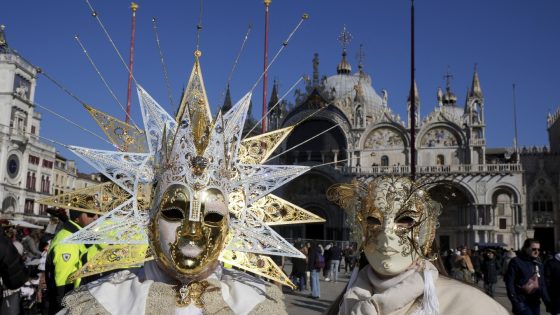PRAYAGRAJ, India (AP) — The ongoing Maha Kumbh festival, which began on January 13 and will conclude on February 26, attracts millions of Hindus to the confluence of the Ganges, Yamuna, and the mythical Saraswati rivers. Participants believe that bathing in these waters cleanses them of sins and helps them attain salvation.
- Naga Sadhu symbolizes Hindu asceticism.
- Maha Kumbh festival attracts millions annually.
- Ritual bathing believed to cleanse sins.
- Festival dates: Jan. 13 to Feb. 26.
- Roots in Vishnu's nectar of immortality.
- Expected participation: nearly 400 million people.
This year, nearly 400 million people are expected to participate in the festival, which is the largest religious gathering in the world. Hindu ascetics, known as Naga Sadhus, are prominent figures at the event, performing rituals that have been passed down through centuries.
The Maha Kumbh festival is rooted in Hindu mythology, where the god Vishnu is said to have retrieved a golden pitcher containing the nectar of immortality from demons. According to tradition, drops of this nectar fell in four locations: Prayagraj, Nasik, Ujjain, and Haridwar. These cities host the Kumbh festival in a rotating cycle, drawing millions of devotees each time.
During the festival, participants engage in daily bathing rituals, particularly on auspicious dates when crowds swell significantly. Key details include:
- Festival duration: January 13 to February 26, 2025.
- Expected participants: Nearly 400 million.
- Significant locations: Confluence of Ganges, Yamuna, and mythical Saraswati rivers.
Hindu ascetics, such as the Naga Sadhus, are integral to the festival. These ascetics, who were historically associated with mercenary armies, now dedicate their lives to the worship of Lord Shiva. Their participation in the festival symbolizes a deep commitment to spiritual practices and the Hindu faith.
The Maha Kumbh festival not only serves as a religious observance but also as a cultural gathering that showcases the rich traditions of Hinduism. It is a time for reflection, community, and spiritual renewal for millions of participants.
The Maha Kumbh festival represents a profound spiritual journey for millions of Hindus, emphasizing the importance of ritual bathing and the belief in divine cleansing. As the festival unfolds, it continues to attract attention globally, highlighting the enduring significance of faith and tradition in contemporary society.









![Right: A wreath reading ″Singer IVE″ stands at the funeral hall for Kim Ha-neul, a 7-year-old girl who was allegedly stabbed to death by a teacher, at the Konyang University Hospital in Daejeon on Feb. 11. Left: Jang Won-young, a member of IVE, who Kim's father asked ″to come and see Ha-neul″ because ″Jang was Ha-neul's dream.″ [NEWS1]](https://news.faharas.net/wp-content/uploads/2025/02/IVE-Sends-Heartfelt-Wreath-to-Funeral-of-7-Year-Old-Stabbing-Victim-560x315.jpg)








![[BREAKING] Fire erupts on Air Busan Plane at Gimhae Airport; All 176 onboard safely evacuated](https://news.faharas.net/wp-content/uploads/2025/01/Fire-Breaks-Out-on-Air-Busan-Flight-at-Gimhae-Airport-230x129.png)






![[VIDEO]'Semoga hubungan yang terjalin tidak putus sampai bila-bila'](https://news.faharas.net/wp-content/uploads/2025/03/Unbreakable-Bonds-How-to-Ensure-Your-Relationships-Last-a-Lifetime-230x129.jpeg)







